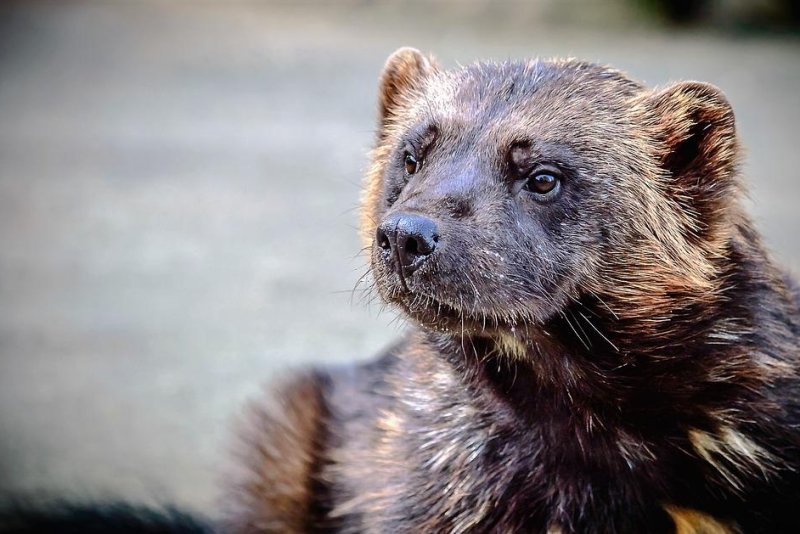Wolverines are tough and solitary and live in the boreal forests, taiga and tundra of the northern latitudes across Europe, Asia and North America. Photo courtesy of Pixabay
June 8 (UPI) -- The first written account of domesticated reindeer herding originates from around the year 800 AD in what is now Arctic Norway. And for the indigenous Saami people of this region, reindeer husbandry remains integral to their culture and identity.
But researchers have known for years that the wolverine, an elusive and fierce boreal predator that is the largest member of the weasel family – males weigh up to 40 pounds – poses a particular threat to reindeer. Then a 2016 study confirmed that reindeer made up the bulk of wolverine diet in Arctic Norway. To keep the wolverines in check, Norway uses culling methods described by the WWF as brutal and outdated: Sometimes helicopters are used to track the animals, then dens are dug out to dislodge and kill the wolverines.
"Wolverines belong to Norwegian nature," wrote Sverre Lundemo, WWF-Norway's predator expert, in a recent commentary. "They are endangered by extinction and were first conserved many years ago. It's time we stop treating the wolverine like a pest."
Rough reputation
Wolverines are tough and solitary and live in the boreal forests, taiga and tundra of the northern latitudes across Europe, Asia and North America. They typically hunt as predators in the summer when young prey are more abundant and vulnerable, and then as scavengers in the winter when the weakest have succumbed to the cold. They even piggyback off other carnivorous predators like lynx.
To this day there remains a primeval, panicky romanticism about them, perhaps because they are so rarely seen and yet dine so voraciously. John Muir wrote in Travels in Alaska that wolves and wolverines were thought to be "companions in sin and equally wicked and cunning;" American poet and author James Dickey imagined the blood-hungry wolverine "surrounding himself with the silence of whitening snarls;" and, most recently, comic books and Hollywood have reconfigured the wolverine as an upright, long-clawed and troubled superhero.
A political problem
Jenny Mattisson, a wolverine researcher at the Norwegian Institute for Nature Research and lead author of the 2016 study on the wolverine diet, said that the government has decided there needs to be a two-part goal for wolverine management: "securing a viable population in Norwegian nature combined with preserving agriculture and reindeer husbandry."
To meet these goals, in 2005 the Norwegian parliament implemented a national target for the wolverine population calculated on the number of new wolverine litters registered each year. This target number of litters – 39 – has not been changed since 2005. When that target number of litters is exceeded, as it has been every year since it came into force, hunting licenses are issued to private individuals and the government conducts its own cull.
But finding wolverines is very difficult, and many hunts are not successful. In 2016, there were 50 litters registered. However, only seven of the 11 excess litters were reported to have been successfully culled. Because of these difficulties, techniques often involve the tracking of wolverines from the air with helicopters and the digging out of dens, including the culling of adults with pups. So far this year, a wolverine and her offspring and a lone male have been culled.
In addition to culling, the government attempts to minimize predation by working with herders to bring reindeer down from the mountains earlier in the year and recommending the use of night-enclosures for the stock. Reindeer herders affected by livestock losses are also compensated financially.
Norway's proposed cull of its wolf population has attracted much more media attention, both nationally and internationally, than its treatment of wolverines. But the wolverine has not entirely escaped the spotlight. The WWF has been critical of the culling techniques, while the state secretary for the Ministry of Climate and Environment has defended the practice as a necessary evil.
Fewer problems across the pond
Across the Atlantic Ocean in North America, leaving aside the ongoing political battle regarding the listing of the animal as an endangered species, direct wolverine-human conflicts are less common.
Rebecca Watters, an executive director of the nonprofit Wolverine Foundation, began her career by researching the wolves of Yellowstone. With this experience under her belt, she joked to a friend that she "just wanted a species that runs around in the mountains and nobody cares about." Her wish appears to have come true. Aside from the shooting of a wolverine by a rancher in North Dakota last year, Watters is aware of only one other potential instance of direct encounter in the continental United States – an anecdotal 1980s report from Wyoming.
In Alaska, the state's Department of Fish and Game seems to view the wolverines as the party under threat, noting on its website that "as human recreational pursuits expand into more remote areas, greater protection of natal denning areas" may be required.
Watters, who has also studied the animals in Mongolia, learned from her interviews with Mongolian goat herders, that they, too, reported extremely limited losses. It is, at root, an issue of space. Once again we are reminded that the Arctic is not a uniform, roomy wilderness – just ask the wolverine.
![]() Glen Jeffries is a lawyer and writer based in Tromsø, in north Norway. This article originally appeared on Arctic Deeply, and you can find the original here. For important news about Arctic geopolitics, economy, and ecology, you can sign up to the Arctic Deeply email list.
Glen Jeffries is a lawyer and writer based in Tromsø, in north Norway. This article originally appeared on Arctic Deeply, and you can find the original here. For important news about Arctic geopolitics, economy, and ecology, you can sign up to the Arctic Deeply email list.















